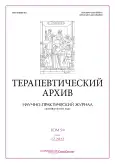Динамика уровней NT-proBNP и ST2 как маркеров сердечной недостаточности у больных эндогенным гиперкортицизмом
- Авторы: Кошарная Р.С.1, Белая Ж.Е.1, Зураева З.Т.1, Мичурова М.С.1, Калашников В.Ю.1
-
Учреждения:
- ФГБУ «Национальный медицинский исследовательский центр эндокринологии» Минздрава России
- Выпуск: Том 94, № 12 (2022)
- Страницы: 1387-1393
- Раздел: Оригинальные статьи
- URL: https://journals.rcsi.science/0040-3660/article/view/144201
- DOI: https://doi.org/10.26442/00403660.2022.12.201995
- ID: 144201
Цитировать
Полный текст
Аннотация
Цель. Изучить частоту встречаемости сердечной недостаточности у пациентов с эндогенным гиперкортицизмом (ЭГ) и оценить взаимосвязь эффективного лечения ЭГ и регресса сердечной недостаточности, учитывая динамику биомаркеров сердечной недостаточности N-терминального фрагмента мозгового натрийуретического пептида (NT-proBNP) и стимулирующего фактора роста, экспрессируемого геном 2 (ST2).
Материалы и методы. В исследование включены 56 пациентов с ЭГ (45 женщин, средний возраст 47 лет [36; 55]), госпитализированных в ФГБУ «НМИЦ эндокринологии» с подтвержденным диагнозом ЭГ с октября 2018 по февраль 2020 г. Всем пациентам при включении в исследование и через 6 мес после хирургического лечения проведены стандартное клинико-инструментальное обследование, эхокардиография с определением глобальной продольной деформации миокарда. Кроме того, определены биомаркеры сердечной недостаточности – NT-proBNP и ST2. В финальный анализ включены 24 пациента, госпитализированные для повторного обследования через 6 мес.
Результаты. На основании клинических данных и повышения уровней NT-proBNP и ST2 у 28 (50%) из 56 пациентов диагностирована сердечная недостаточность. Ремиссия ЭГ подтверждена у 20 пациентов. Последующие исследования с акцентом на изменения уровней NT-proBNP и ST2 продемонстрировали, что стойкая ремиссия ЭГ привела к регрессу сердечной недостаточности у 11 (55%) пациентов.
Заключение. Предварительные данные свидетельствуют о том, что признаки и симптомы сердечной недостаточности наблюдаются у больных ЭГ примерно в 1/2 случаев. Стойкая ремиссия ЭГ приводит к регрессу сердечной недостаточности в 1/2 случаев. Проспективная оценка уровней NT-proBNP и ST2 может дать важную диагностическую и прогностическую информацию у пациентов с ЭГ.
Полный текст
Открыть статью на сайте журналаОб авторах
Раиса Станиславовна Кошарная
ФГБУ «Национальный медицинский исследовательский центр эндокринологии» Минздрава России
Автор, ответственный за переписку.
Email: kosharnaya.raisa@mail.ru
ORCID iD: 0000-0003-1387-683X
SPIN-код: 9349-6790
врач-кардиолог отд-ния кардиологии, эндоваскулярной и сосудистой хирургии
Россия, МоскваЖанна Евгеньевна Белая
ФГБУ «Национальный медицинский исследовательский центр эндокринологии» Минздрава России
Email: kosharnaya.raisa@mail.ru
ORCID iD: 0000-0002-6674-6441
д-р мед. наук, гл. науч. сотр., зав. отд-нием нейроэндокринологии и остеопатий
Россия, МоскваЗамира Тотразовна Зураева
ФГБУ «Национальный медицинский исследовательский центр эндокринологии» Минздрава России
Email: kosharnaya.raisa@mail.ru
ORCID iD: 0000-0001-6953-6928
канд. мед. наук, эндокринолог, сотр. клинико-диагностической лаборатории
Россия, МоскваМарина Сергеевна Мичурова
ФГБУ «Национальный медицинский исследовательский центр эндокринологии» Минздрава России
Email: kosharnaya.raisa@mail.ru
ORCID iD: 0000-0003-1495-5847
науч. сотр. отд-ния кардиологии, эндоваскулярной и сосудистой хирургии
Россия, МоскваВиктор Юрьевич Калашников
ФГБУ «Национальный медицинский исследовательский центр эндокринологии» Минздрава России
Email: kosharnaya.raisa@mail.ru
ORCID iD: 0000-0001-5573-0754
чл.-кор. РАН, д-р мед. наук, проф., зав. отд. кардиологии и сосудистой хирургии
Россия, МоскваСписок литературы
- Мельниченко Г.А., Дедов И.И., Белая Ж.Е., и др. Болезнь Иценко–Кушинга: клиника, диагностика, дифференциальная диагностика, методы лечения. Проблемы эндокринологии. 2015;61(2):55-77 [Melnichenko GA, Dedov II, Belaya ZE, et al. Cushing’s disease: the clinical features, diagnostics, differential diagnostics, and methods of treatment. Problems of Endocrinology. 2015;61(2):55-77 (in Russian)]. doi: 10.14341/probl201561255-77
- Lacroix A, Feelders RA, Stratakis CA, Nieman LK. Cushing’s syndrome. Lancet. 2015;386(9996):913-27. doi: 10.1016/S0140-6736(14)61375-1
- Kamenický P, Redheuil A, Roux C, et al. Cardiac structure and function in Cushing’s syndrome: A cardiac magnetic resonance imaging study. J Clin Endocrinol Metab. 2014;99(11):E2144-53. doi: 10.1210/jc.2014-1783
- Javanmard P, Duan D, Geer EB. Mortality in patients with endogenous Cushing’s syndrome. Endocrinol Metab Clin North Am. 2018;47(2):313-33. doi: 10.1016/j.ecl.2018.02.005
- van Haalen FM, Broersen LHA, Jorgensen JO, et al. Management of endocrine disease: Mortality remains increased in Cushing’s disease despite biochemical remission: a systematic review and meta-analysis. Eur J Endocrinol. 2015;172(4):R143-9. doi: 10.1530/EJE-14-0556
- Clayton RN, Jones PW, Reulen RC, et al. Mortality in patients with Cushing’s disease more than 10 years after remission: a multicentre, multinational, retrospective cohort study. Lancet Diabetes Endocrinol. 2016;4(7):569-76. doi: 10.1016/S2213-8587(16)30005-5
- Di Dalmazi G, Pasquali R. Adrenal adenomas, subclinical hypercortisolism, and cardiovascular outcomes. Curr Opin Endocrinol Diabetes Obes. 2015;22(3):163-8. doi: 10.1097/MED.0000000000000153
- Libby P, Bonow RO, Mann DL, et al. Braunwald's heart disease: a textbook of cardiovascular medicine. Philadelphia: Saunders/Elsevier, 2021.
- Isidori AM, Graziadio C, Paragliola RM, et al. The hypertension of Cushing’s syndrome. J Hypertens. 2015;33(1):44-60. doi: 10.1097/HJH.0000000000000415
- Kamenický P, Redheuil A, Roux C, et al. Cardiac structure and function in Cushing’s syndrome: A cardiac magnetic resonance imaging study. J Clin Endocrinol Metab. 2014;99(11):E2144-53. doi: 10.1210/jc.2014-1783
- Wagner J, Langlois F, Lim DST, et al. Hypercoagulability and risk of venous thromboembolic events in endogenous Cushing’s syndrome: a systematic meta-analysis. Front Endocrinol (Lausanne). 2019;9(11):E2144-53. doi: 10.3389/fendo.2018.00805
- Small M, Lowe GDO, Forbes CD, Thomson JA. Thromboembolic complications in Cushing’s syndrome. Clin Endocrinol (Oxf). 1983;19(4):503-11. doi: 10.1111/j.1365-2265.1983.tb00025.x
- Отто К. Клиническая эхокардиография: практическое руководство. М.: Логосфера, 2019 [Otto K. Klinicheskaia ekhokardiografiia: prakticheskoe rukovodstvo. Moscow: Logosfera, 2019 (in Russian)].
- Shah RV, Januzzi JL. Soluble ST2 and Galectin-3 in heart failure. Clin Lab Med. 2014;34(1):87-97. doi: 10.1016/j.cll.2013.11.009
- Aimo A, Vergaro G, Passino C, et al. Prognostic Value of Soluble Suppression of Tumorigenicity-2 in Chronic Heart Failure. JACC Hear Fail. 2017;5(4):280-6. doi: 10.1016/j.jchf.2016.09.010
- Aimo A, Vergaro G, Ripoli A, et al. Meta-Analysis of Soluble Suppression of Tumorigenicity-2 and Prognosis in Acute Heart Failure. JACC Hear Fail. 2017;5(4):287-96. doi: 10.1016/j.jchf.2016.12.016
- Wang TJ, Wollert KC, Larson MG, et al. Prognostic Utility of Novel Biomarkers of Cardiovascular Stress. Circulation. 2012;126(13):1596-604. doi: 10.1161/CIRCULATIONAHA.112.129437
Дополнительные файлы











